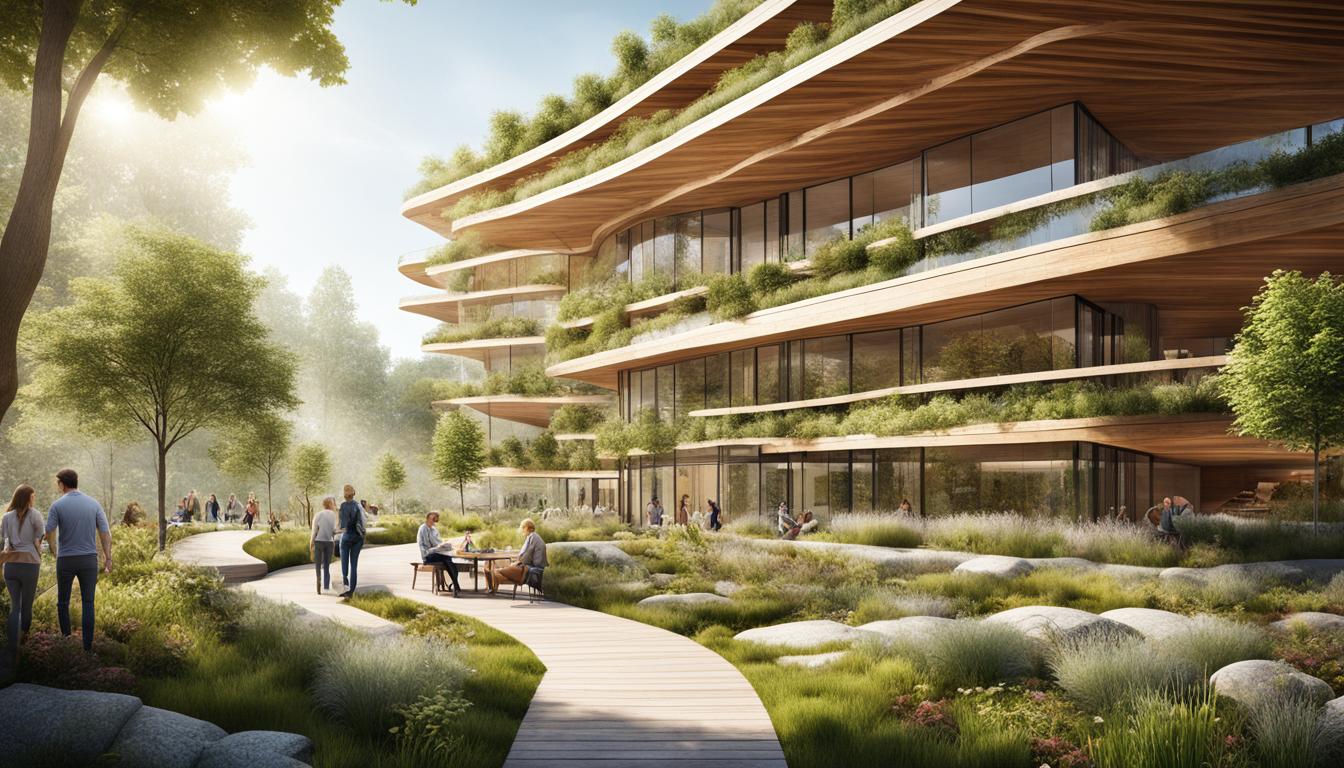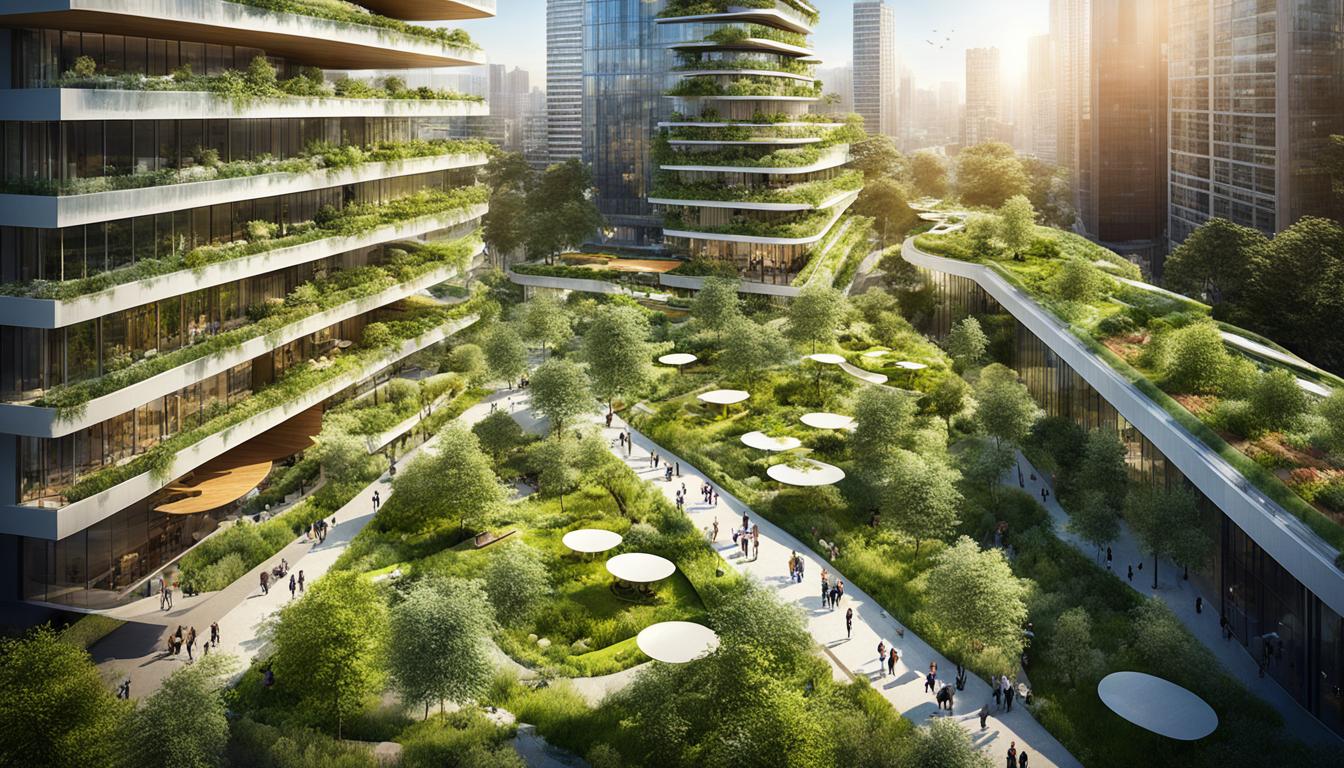Wildlife-Friendly Urban Architecture: Balancing Human and Ecological Needs
By 2050, around 70% of us will live in cities. This figure highlights the urgent task of merging cities with nature. This link between our cities and the natural world is crucial. Wildlife-friendly urban architecture mixes biophilic design, green infrastructure, and sustainable development. It does this to make our urban spaces friendly to urban biodiversity and good for humans too.
Ecological architecture combines sustainability and environmental consciousness in building design. The goal is to have buildings that work well with nature, causing little harm. In this type of design, experts try to save and add to the natural elements and ecosystems in our cities. They do this by adding green spaces, using renewable energy sources, and making smart choices about where to build.
Focusing on ecological considerations means designing to lower our carbon footprint and use less energy. Ecological architecture wants to make places that fit in with nature and the local ecosystem. It knows the key is a balanced link between what we build and nature.
Key Takeaways
- Ecological architecture integrates sustainability and environmental consciousness into building design.
- It aims to create structures that coexist harmoniously with natural surroundings, minimising ecological impact.
- Architects and designers strive to preserve and complement natural elements and ecosystems within urban environments.
- Ecological architecture prioritises minimising carbon footprint and reducing energy consumption.
- It recognises the importance of a balanced relationship between human activity and ecosystem preservation.
Introduction to Ecological Architecture
Sustainable building plays a key role in ecological architecture. It helps protect the environment and fosters a link between buildings and ecology. Ecology is vital in architectural design. It looks at the close ties between buildings and nature. By following ecological principles, architects make spaces that are kind to nature. These spaces also boost biodiversity and benefit people and the planet.
Sustainable Building Practices
Green building practices impact cities greatly. They use sustainable materials and systems that save energy. This cuts down on carbon emissions and lowers the use of resources. It also helps reduce the heat in city areas. Not just that, it makes city life better for people.
The Role of Ecology in Architectural Design
Ecology is essential in architectural design. It guides architects to make buildings that fit well with nature. They learn how buildings and the environment can work together. This knowledge helps them design structures that are good for nature and for people.
Impact of Green Building Practices
Green building practices change cities for the better. Architects use eco-friendly materials and energy-saving systems. They aim to boost biodiversity too. This lowers buildings’ impact on the planet, uses fewer resources, and improves city living.
Relationship Between Architecture and Nature
Building and nature must find a careful balance. Good design helps make structures that live well with nature. They protect and cherish natural parts like trees and water. This approach in ecological architecture aims for beautiful spaces. These spaces deepen our love for nature.
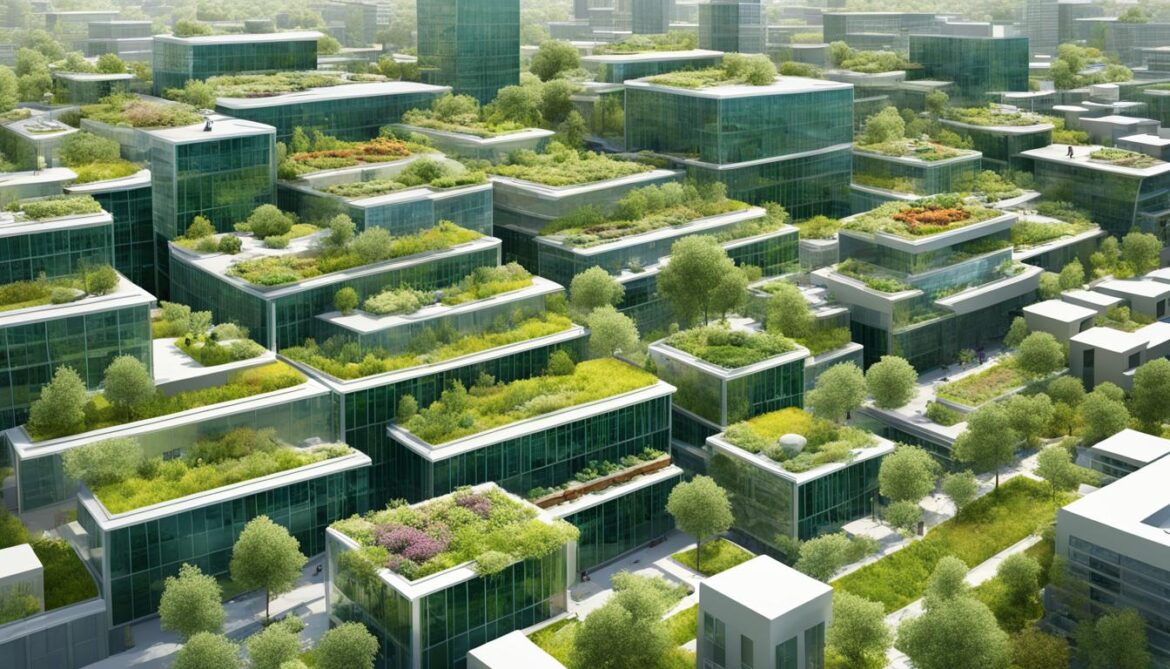
Remarkable Case Studies
This section looks at some groundbreaking case studies in ecological architecture. They show how buildings can fit well in nature. They also use designs that are good for the planet. Thus, they help make our cities more eco-friendly.
Angkor Wat: Ancient Integration of Architecture and Nature
Angkor Wat is a UNESCO site in Cambodia where architecture meets nature. This temple complex, made in the 12th century, perfectly mixes with the lush environment and waters around it. The careful patterns and skilled work here show us how architecture and nature can live together beautifully.
Contemporary Ecological Architecture
In our time, contemporary ecological architecture is growing fast. It uses smart designs and green materials. The use of solar panels, systems to catch rainwater, and smart tech in buildings is common. This way, architects create buildings that are good for the planet and use energy well. These buildings are model homes for sustainable living, where design and eco-care meet.
Green Roofs: Enhancing Urban Environments
Green roofs are becoming very popular because they make cities better and also help nature. They are roofs covered in plants. These roofs make the city handle rain better, clean the air, and keep the temperature just right. They offer space for growing food in the city and make little nature spots. This helps more plants and animals to live in crowded cities.

Design and Materials
Design and materials are vital in ecological architecture. They make sure sustainable methods and a deep connection to nature are part of the design. Architects do this by using materials from the area. This not only lessens the harm on the environment but also helps the local economy. The approach also makes the design unique to its location.
Local materials in eco-friendly buildings may include reclaimed wood, natural stone, and bamboo. These items are not just good for the earth. Their textures and warmth also look beautiful. In these kinds of architecture, fitting the building with its natural surroundings is crucial. The goal is to have human-made structures become part of the environment as if naturally.
Incorporating Local Materials
Choosing materials from nearby is a central value in green building practices. It cuts down on the energy needed to move materials and keeps the air cleaner. This way, buildings fit uniquely into their surroundings and leave a smaller mark on the planet.
Blending Design with Nature
Green building isn’t just about how the outside of a building looks. It’s also about creating indoor spaces that are good for people and the planet. Architects focus on using safe, renewable materials for the insides. This helps make the air we breathe cleaner and reduces our contact with harmful substances. It also makes us feel closer to nature even when inside a building.
Eco-Friendly Interiors
Green building isn’t just about how the outside of a building looks. It’s also about creating indoor spaces that are good for people and the planet. Architects focus on using safe, renewable materials for the insides. This helps make the air we breathe cleaner and reduces our contact with harmful substances. It also makes us feel closer to nature even when inside a building.
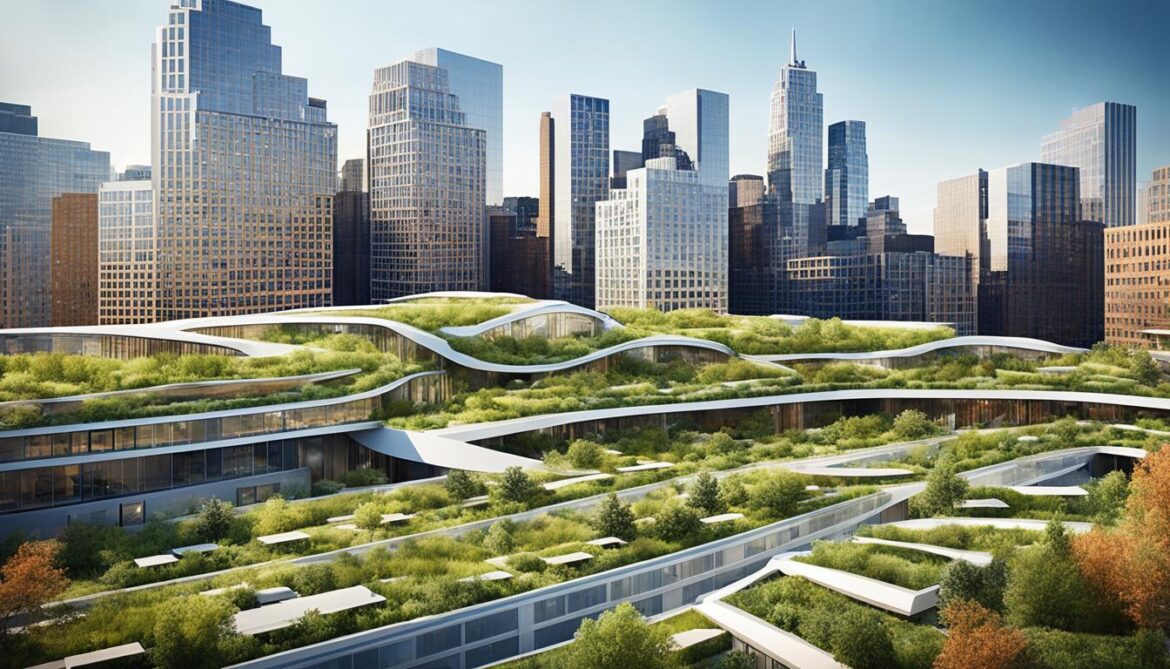
Energy Efficiency in Ecological Architecture
Energy efficiency is key in ecological building design. It aims to reduce a building’s impact on the planet. It does this by using less energy from usual sources. One helpful way is using new techniques for heating and cooling which save a lot of energy.
Innovative Heating and Cooling Techniques
Architects use clever design to keep buildings the right temperature. They don’t need as much heating or cooling. This includes using the position of the building, letting in natural air, and good insulation. Adding smart heating and cooling equipment, like heat pumps and radiant heating, also lessens the need for lots of energy.
Integrating Renewable Energy Sources
Using renewable energy is a big part of energy-efficient building. It means putting things like solar panels, wind turbines, and geothermal heating into the building. This makes buildings make their own clean power. It is a great way to use less fossil fuel and help the environment.
The Future of Energy Conservation
The future looks promising for saving more energy in buildings. New technology and materials can make buildings even more efficient. For example, some buildings can use the same amount of energy they make. There’s also the chance to use smart systems and artificial intelligence to use energy better, make people more comfortable, and do less harm to the world.
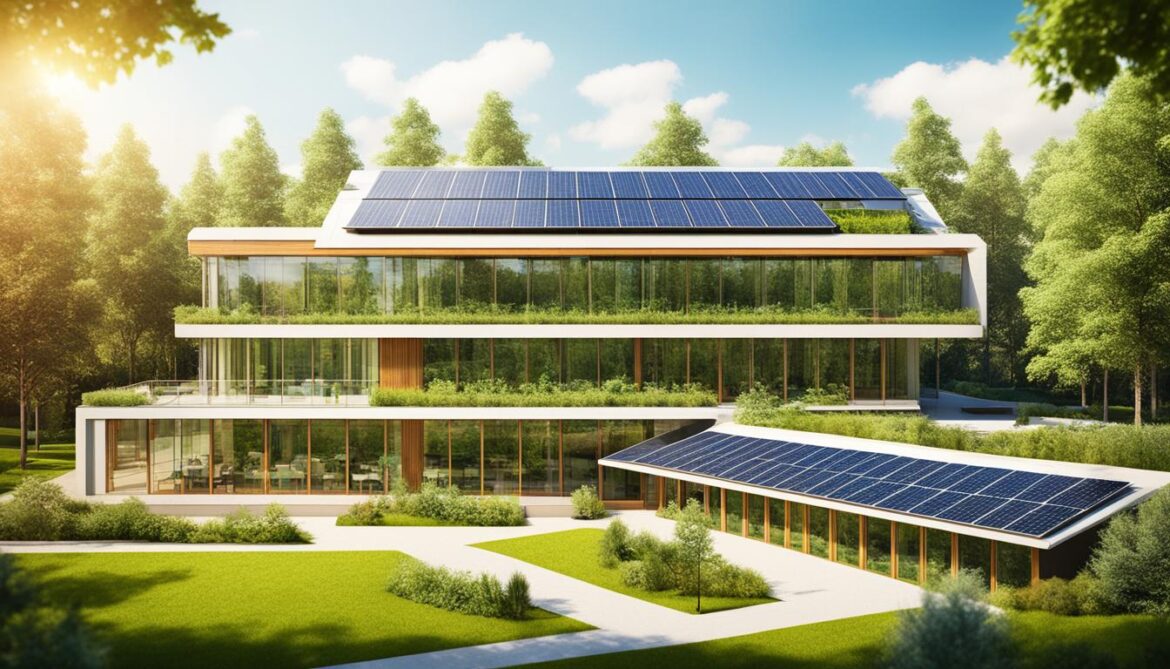
Wildlife-Friendly Urban Architecture: Balancing Human and Ecological Needs
In sustainable city design, there’s a key balance to strike. It’s between what people need and the natural world we live in. Wildlife-friendly urban architecture is central to this. It ensures buildings and nature can thrive together. By designing with nature in mind, architects help create places where people and wildlife can both flourish.
This part delves into how ecological architecture links human living with preserving nature. Designers use clever plans and materials to build urban areas that are good for both us and wildlife. It’s about making cities that support life, from plants to animals.

By using ecological architecture, city planners can do more than build homes and streets. They can make spaces that help humans connect with nature. This leads to cities that are good for everyone living there. They are places where wildlife and people can share and enjoy together.
Biodiversity and Nature Conservation
Biodiversity and nature conservation are key for building sustainable cities. By focusing on these, cities can thrive with both people and nature living in harmony.
Creating Green Spaces
Adding green spaces like parks and gardens helps wildlife and people alike. These areas provide food, shelter, and connections for many species. They also make city life better, boosting health and happiness.
Promoting Native Plants
Using plants native to the region helps urban wildlife. These plants are perfect for the local weather and soil. They also help birds, bees, and many other animals, keeping the city’s ecosystem in balance.
Reducing Human-Wildlife Conflicts
It’s crucial to minimize clashes between people and wildlife in cities. Problems can arise from animals damaging property or vice versa. City planning should include steps to teach, prevent, and manage these issues. This way, everyone can live peacefully.
Habitat Connectivity and Wildlife Corridors
Habitats and corridors are key for wildlife, offering food, shelter, and water. They provide areas for breeding and safe passage. Introducing habitats and corridors in a project boosts its ecological value and benefits both wildlife and people.
Importance of Habitats and Corridors for Wildlife
Wildlife habitats and corridors are essential for maintaining biodiversity. They support urban animal populations over the long run. These areas help creatures move, access resources, and find places to breed, making urban areas more habitable for them.
Urban planners play a critical role by creating and preserving these habitats. They lessen the effects of city growth on wildlife, ensuring they can thrive.
Assessing and Selecting Suitable Habitats and Corridors
Assessing the land before designing is crucial. It involves surveys and map studies to understand the local environment and animal needs. The aim is to identify the best areas for wildlife to live and move through.
When choosing habitats and corridors, many factors are considered. These include site characteristics, project aims, and available resources. Careful consideration is needed to make the best choices for wildlife.
Designing Functional Habitats and Corridors
Creating these areas requires thinking about what plants and structures to use. The focus is on making surroundings where wildlife can find everything they need. This involves looking at what nature does and copying the best bits.
Corridors need to be designed well for animals to move through easily. Their layout should support different species and help them travel without trouble. This ensures wildlife can move freely in the city.

Urban Ecology and Ethical Principles
Urban ecology looks at how living things interact with cities. It studies these interactions and the patterns they create. This approach helps urban planners deal with the many challenges related to urban wildlife and people.
For dealing with urban life, city planners should follow certain ethics. These include respect, responsibility, fairness, and care. Practicing these can help planners understand the value of urban wildlife. It also helps them think about the rights and needs of all people.
These ethical principles guide planners to be careful and ready to learn from what they do. They encourage a careful, thoughtful approach. This is especially important when dealing with the unpredictability of urban life.

When urban planners follow these ethical rules, everyone wins. The city becomes a better place for both people and nature. This sustainable, inclusive development is good for our planet and its inhabitants.
Conclusion
Wildlife-friendly urban architecture is key to meeting both human and nature’s needs. By following ecological principles and using sustainable design, architects can help the environment. They do this by focusing on biodiversity and conserving nature.
Architects and planners make spaces that work with nature. They use local materials and energy-saving methods. They also build places for wildlife and connections between them.
As cities grow, it’s vital to build in ways that support our planet. Making cities with wildlife in mind helps both people and nature. It ensures we live well and protect the Earth.
Choosing nature in our city plans makes our communities better. It shows we care about nature and still meet human needs. This way, everyone benefits.
Wildlife-friendly architecture shows that design can create a better future. A future where our buildings and nature live in harmony. It’s all about working together for a sustainable planet.
FAQ
What is ecological architecture?
Ecological architecture focuses on green design. It brings together sustainability and respect for nature. The goal is to build in ways that fit well into the environment. This minimises harm and moves us towards a greener future.
How do sustainable building practices contribute to ecological architecture?
Sustainable building aims to protect our planet. By using green methods, it helps buildings and nature work together. This results in spaces that care for the earth and support plant and animal life.
What are some remarkable case studies of ecological architecture?
One case study is Angkor Wat in Cambodia. It shows how architecture and nature can blend beautifully. Today, modern ecological buildings use smart tech and green roofs to make cities greener places.lk](www.example.com).
How do design and materials contribute to ecological architecture?
Design and materials are key in ecological architecture. They make sure buildings are friendly to the planet. Using materials from nearby, adding natural touches, and creating eco-inside areas make a big difference.
What is the role of energy efficiency in ecological architecture?
Energy efficiency cuts down building’s damage to the earth. It means using less energy and more sustainable power sources. This includes smart ways to heat and cool spaces without harming the environment.
How do biodiversity and nature conservation contribute to wildlife-friendly urban architecture?
Protecting nature in cities helps make them better places for both people and wildlife. Green areas, native plants, and working to avoid problems between people and animals are part of this.
What is the importance of habitat connectivity and wildlife corridors in ecological architecture?
Habitats and corridors help animals thrive. They connect lands for safe travel and important resources. Adding these features to design benefits both wildlife and us.
How does urban ecology and ethical principles guide wildlife-friendly urban architecture?
Urban ecology looks at the bigger picture of city life, including wildlife. Ethical principles like fairness and caring help planners make cities where both animals and people can live well.



